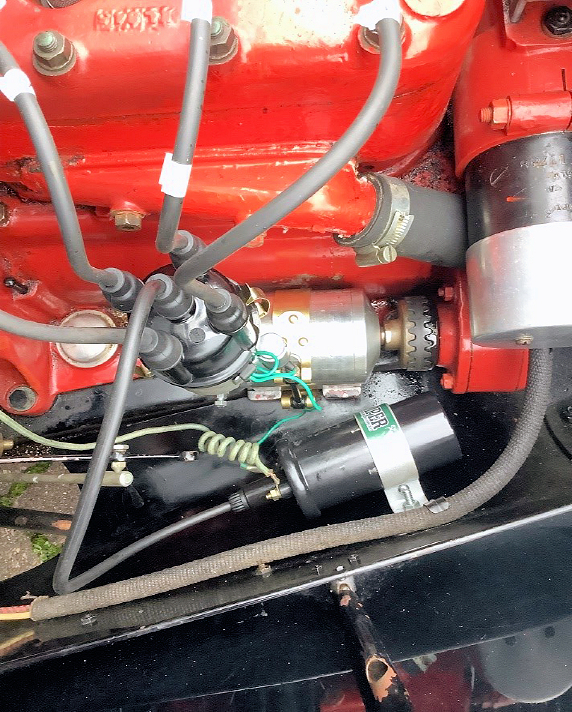 s
at Holton Heath, manufactures a complete magneto to coil conversion kit - a very
neat job. Contact: Telephone 01202 625242; Email: arpmckenzie@hotmail.co.uk.
s
at Holton Heath, manufactures a complete magneto to coil conversion kit - a very
neat job. Contact: Telephone 01202 625242; Email: arpmckenzie@hotmail.co.uk.
CONVERTING CHUMMY MAGNETO TO COIL IGNITION
See below for details of a new, ready-to-buy conversion kit
After having towed my sister and ‘26 Chummy 50 miles at 5 a.m. in the morning after 3 Magnetos had packed up, I decided that enough was enough! I had heard several rumours of rebuilt units lasting all of 100 miles which meant only one solution — pushing the car over the nearest cliff! But just as the front wheels slipped over the edge, I had a brain wave ( a very rare occurrence) as follows:
The Magneto in question is a BLICC A4R (fitted to many A7s) which has all the essential ingredients of a normal distributor, i.e. points, rotor arm and cap all geared to suit engine speed.
A) The low tension circuit (negative earth)
I used the original wire which runs from switch panel (ignition terminal) to the magneto points, (which usually shorts the points to earth to switch the engine off). In the case of the (1928—31) Lucas switch panel, the wire must be removed from this terminal and reconnected to a positive one (B + etc.) The cable must then be switched (to turn ignition on and off). I put a small toggle switch hidden under the dash. In the case of the early CAV panel it should be possible to use the original switch if it is wired positive instead of to earth. No doubt even with the Lucas panel and plenty of time it would be possible with parts from the later coil ignition panel (1928—31) to use the original switch for on/off. It really depends how permanent you intend to make the modification. From this switch the cable is cut at a suitable length to join to the SW (switch) terminal of a normal 6 volt coil — ancient or modern. The remaining bare end of the wire should be connected to the C.B. (contact breaker, not citizens band) terminal of the aforementioned coil. This last bit of the wire just continues on to its usual terminal on the Mag. as previously, which now incidentally provides the positive power to the points — instead of the previously negative short circuit.
There must be a condenser across the points, so I took off the aluminium top cover of the Mag., unbolted the Magneto’s original Coil and condenser an fitted on a normal A7 coil ignition condenser — the body strap of which was fitted to one of the lid nuts (earth) and the terminal of it was connected to the wire which comes up from the points to the Mag. It may be possible to use the original Magneto condenser in situ, but I think it is of a different resistance (so, as this is all a bit above me, I decided to play it safe and fit the coil condenser!) This completes the low tension circuit as the points go to earth, via the Mag body and chassis to the battery.
B) The high tension circuit
This circuit runs through the usual HT cable from the coil HT terminal via a hole drilled in an inconspicuous place in the Magneto lid to the ferule where the original Mag. coil sent its power to the distributor cap rotor, thus the spark plugs will be fed with sparks exactly as originally.
With my unit I bolted the coil inside the dash and ran the 7mm HT cable unseen to the Magneto lid hole, so that at a first glance the system looks entirely original — only one difference, it won’t melt its SHELLAC half way across the Atacam Desert.
There is no reason why this modification can’t be used on any Magneto but I think an the design where the points themselves rotate and the original earthing wire worked on a carbon brush on an end cap (à la Lucas) there may not be a sufficiently reliable contact to make a good low tension circuit.
This modification can either be made fairly permanent, or if a condenser, coil and HT cable are slung under the back seat it could be rigged across a battery temporarily at the road side in 10 mins. as a get you home measure!
The beauty of this idea is that if you do hear of someone who rebuilds Magnetos properly then the Magneto hasn’t been irrecoverably damaged and can be easily be put back into full original service.
Gary Munn
Gary first wrote this article in the club newsletter in 1983! On re-reading it, he didn't change one word!! - that’s good engineering skill. Many thanks, Gary—keep the articles coming every 21 years and I’ll be very happy—Ed.
UPDATE - MAGNETO TO COIL IGNITION CONVERSION KIT
Willie Mackenzie at Austin Reproduction Part s
at Holton Heath, manufactures a complete magneto to coil conversion kit - a very
neat job. Contact: Telephone 01202 625242; Email: arpmckenzie@hotmail.co.uk.
s
at Holton Heath, manufactures a complete magneto to coil conversion kit - a very
neat job. Contact: Telephone 01202 625242; Email: arpmckenzie@hotmail.co.uk.
Open 8.30am – 4.30pm Monday – Friday, 9.am-1pm Saturday. Address: Unit 29 Glenmore Business Park, Blackhill Road, Holton Heath, Poole BH16 6N